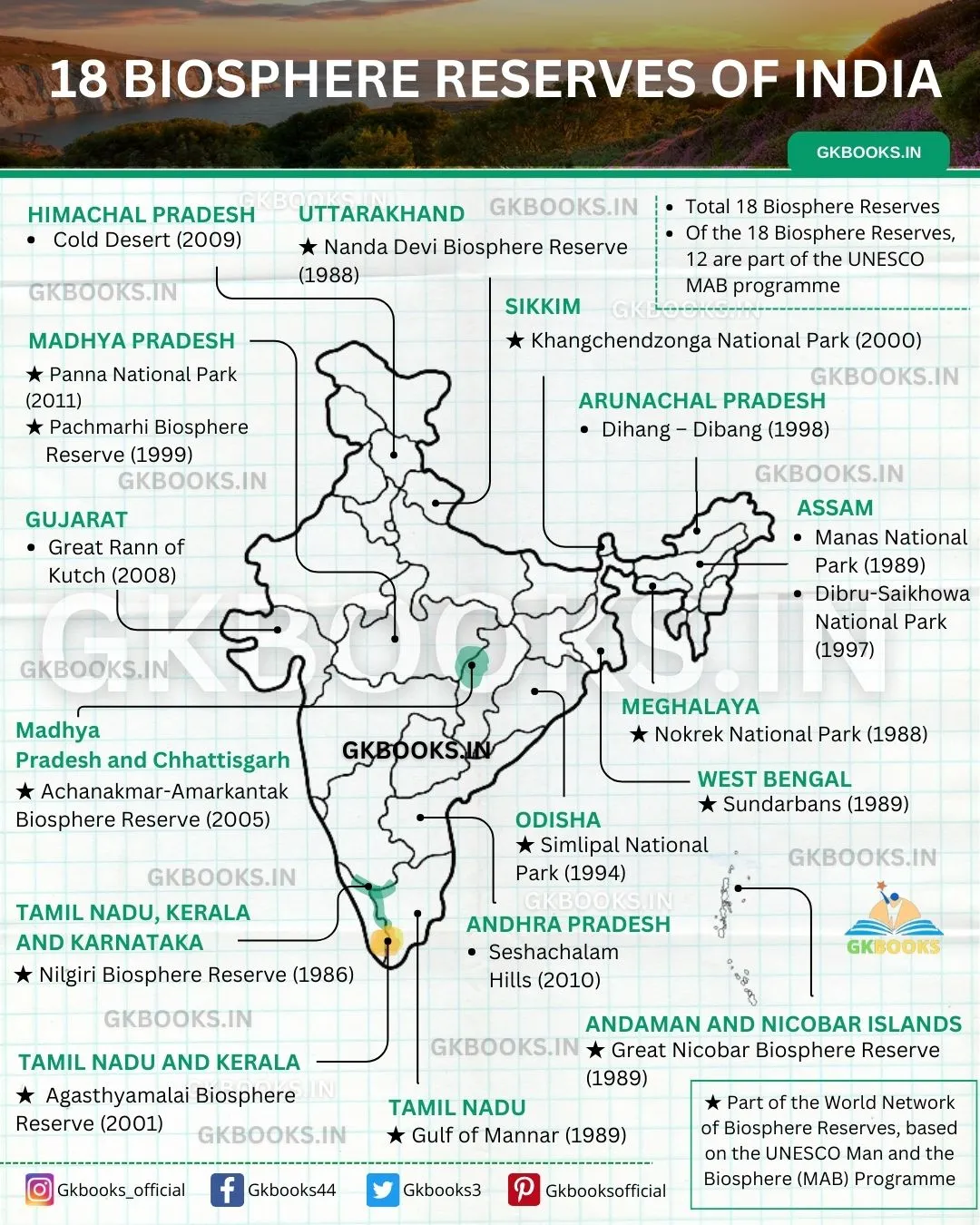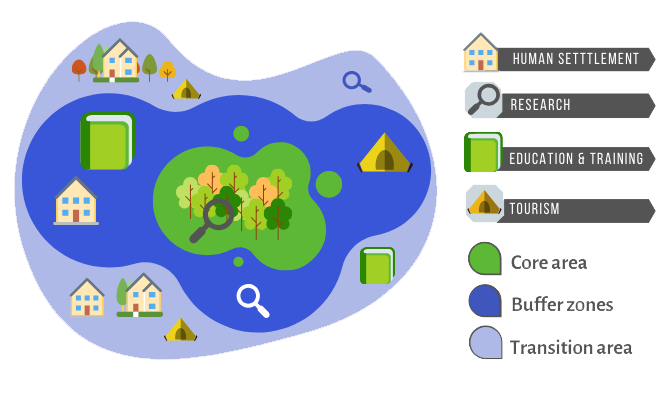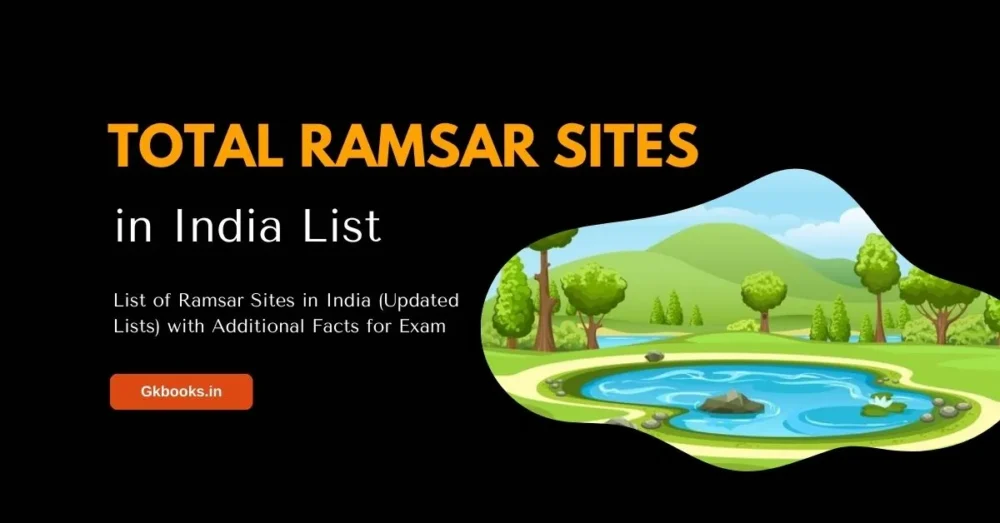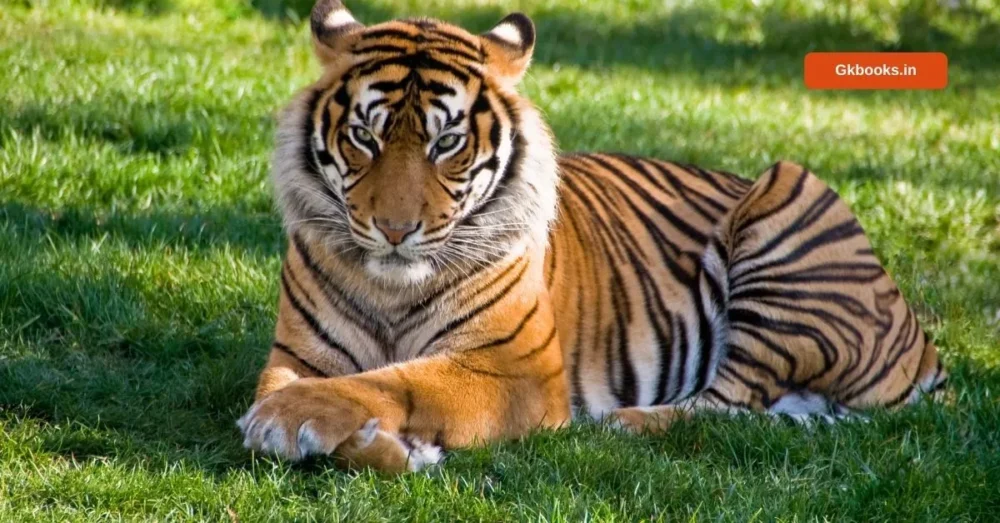Here is the updated list of Biosphere Reserves in India. At present India has 18 biosphere reserves. The latest biosphere reserve is the Panna Biosphere Reserve in Madhya Pradesh. Recently (in 2020) Panna National Park in Madhya Pradesh has been declared a UNESCO Biosphere Reserve under the MAB programme.
Here is the list of 18 Biosphere Reserves in India with the year of recognition and associated states.
List of 18 Biosphere reserves in India
| Sl.No | Name | Year | State |
|---|---|---|---|
| 1 | Nilgiri Biosphere Reserve | 1986 | Tamil Nadu, Kerala and Karnataka |
| 2 | Nanda Devi Biosphere Reserve | 1988 | Uttarakhand |
| 3 | Gulf of Mannar | 1989 | Tamil Nadu |
| 4 | Nokrek | 1988 | Meghalaya |
| 5 | Sundarbans | 1989 | West Bengal |
| 6 | Manas | 1989 | Assam |
| 7 | Simlipal | 1994 | Odisha |
| 8 | Dihang – Dibang | 1998 | Arunachal Pradesh |
| 9 | Pachmarhi Biosphere Reserve | 1999 | Madhya Pradesh |
| 10 | Achanakmar-Amarkantak Biosphere Reserve | 2005 | Madhya Pradesh, Chhattishgarh |
| 11 | Great Rann of Kutch | 2008 | Gujarat |
| 12 | Cold Desert | 2009 | Himachal Pradesh |
| 13 | Khangchendzonga National Park | 2000 | Sikkim |
| 14 | Agasthyamalai Biosphere Reserve | 2001 | Kerala, Tamil Nadu |
| 15 | Great Nicobar Biosphere Reserve | 1989 | Andaman and Nicobar Islands |
| 16 | Dibru-Saikhowa | 1997 | Assam |
| 17 | Seshachalam Hills | 2010 | Andhra Pradesh |
| 18 | Panna | 2011 | Madhya Pradesh |
Out of the 18 Biosphere Reserves, 12 are listed under the UNESCO Man and the Biosphere (MAB) Programme. Here is the list:
Biosphere Reserves in India under UNESCO MAB Programme
| Name | States/ UT | Year |
|---|---|---|
| 1. Nilgiri Biosphere Reserve | Tamil Nadu, Kerala and Karnataka | 2000 |
| 2. Gulf of Mannar Biosphere Reserve | Tamil Nadu | 2001 |
| 3. Sundarbans Biosphere Reserve | West Bengal | 2001 |
| 4. Nanda Devi Biosphere Reserve | Uttarakhand | 2004 |
| 5. Nokrek Biosphere Reserve | Meghalaya | 2009 |
| 6. Pachmarhi Biosphere Reserve | Madhya Pradesh | 2009 |
| 7. Simlipal Biosphere Reserve | Odisha | 2009 |
| 8. Great Nicobar Biosphere Reserve | Andaman & Nicobar Islands | 2013 |
| 9. Achanakmar-Amarkantak Biosphere Reserve | Chhattisgarh, Madhya Pradesh | 2012 |
| 10. Agasthyamalai Biosphere Reserve | Kerala and Tamil Nadu | 2016 |
| 11. Khangchendzonga National Park | Sikkim | 2018 |
| 12. Panna Biosphere Reserve | Madhya Pradesh | 2020 |
18 Biosphere Reserves in India MAP

What is the UNESCO MAB Programme?
- The Man and the Biosphere (MAB) Programme is an intergovernmental scientific initiative launched by UNESCO in 1971.
- Its primary goal is to establish a scientific foundation for enhancing the relationship between people and their environments.
- By combining natural and social sciences, the MAB Programme aims to improve human livelihoods while safeguarding natural and managed ecosystems.
- The World Network of Biosphere Reserves, a dynamic and interactive network of excellence, fosters harmony between people and nature through participatory dialogue, knowledge sharing, poverty reduction, cultural respect, and sustainable development.
The World Network of Biosphere Reserves of the MAB Programme fosters the harmonious integration of people and the nature of sustainable development through___
- Participatory dialogue
- Knowledge sharing
- Poverty reduction
- Human well-being improvements
- Respect for cultural values
- Society’s ability to cope with change.
- To improve human livelihoods, the MAB combines natural and social sciences, economics and education.
- In other words, it is a main international tool for developing and implementing sustainable development approaches in a wide array of contexts.
Why Does It Matter?
- The MAB Programme combines science, economics, and education to create sustainable solutions.
- It’s like a global toolbox for making the world a better place—one biosphere at a time!
Great, you now have the basic and important list of Biosphere Reserves. But if you want to know more details, crucial facts, and detailed insights about each Biosphere Reserve, keep reading. Let’s uncover everything about Biosphere Reserves in India.
What is a Biosphere?
- The biosphere is a relatively thin layer on Earth’s surface that extends from a few kilometers into the atmosphere down to the deep-sea vents in the ocean.
- It’s a global ecosystem composed of living organisms (called biota) and nonliving factors (such as air, water, and soil) from which they obtain energy and nutrients.
- Essentially, it’s the “zone of life” where living things interact with their environment!
- The biosphere is divided into regions called biomes.
- Biomes are the largest of the five organizational levels.
Classification of Biome
Scientists categorize biomes into five primary types:
1. Aquatic Biome: This biome includes all water bodies on Earth, such as oceans, lakes, rivers, and wetlands. It’s further divided into two main types:
- Marine Biome: Found in saltwater environments (oceans and seas), home to diverse marine life like fish, whales, and coral reefs.
- Freshwater Biome: Found in freshwater environments (lakes, rivers, and ponds), supporting species like fish, amphibians, and waterfowl.
2. Desert Biome: Deserts are dry, arid regions with little rainfall. They can be hot (like the Sahara) or cold (like the Gobi). Adapted plants (such as cacti) and animals (like camels) thrive here.
3. Forest Biome: Forests cover large areas and are home to various trees, plants, and animals. There are three main types:
- Tropical Rainforest: Found near the equator, with lush vegetation and high biodiversity.
- Temperate Forest: Found in moderate climates, with deciduous trees (like oak and maple).
- Coniferous Forest (Taiga): Dominated by evergreen trees (like pine and spruce) and found in colder regions.
4. Grassland Biome: Grasslands have vast stretches of grasses and few trees. They’re divided into:
- Prairies: Found in North America, with tall grasses.
- Savannas: Found in Africa, with scattered trees and grasses. Home to animals like zebras and giraffes.
5. Tundra Biome: Tundras are cold, treeless regions near the Arctic Circle. The ground is frozen (permafrost), and hardy plants (like mosses and lichens) survive here.
What are Biosphere Reserves?
- The Biosphere Reserves are the specific regions of a biome reserved for conserving all forms of life, along with its support system.
- These reserves also aim to restore traditional ways of life for tribal communities living in those regions. Essentially, they help protect biodiversity while promoting sustainable coexistence between people and their environment.
What are the benefits of Biosphere Reserves?
Biosphere reserves offer several benefits, especially in promoting sustainable development and biodiversity conservation. Here are some key advantages:
- Sustainable Development: Biosphere reserves encourage the wise use of natural resources, ensuring long-term sustainability. By balancing conservation with human activities, they promote economic growth without compromising the environment.
- Biodiversity Protection: These reserves serve as living laboratories for studying ecosystems and species. They help address land use challenges, protect endangered species, and maintain ecological balance.
- Research Opportunities: Biosphere reserves provide platforms for academic and government research. Scientists study local issues, monitor environmental changes, and develop solutions to global challenges.
- Economic Revitalization: By promoting diverse local economies, biosphere reserves contribute to rural development. Sustainable tourism, traditional crafts, and eco-friendly practices create livelihood opportunities.
- Community Well-Being: The well-being of local communities, including tribal populations, improves through sustainable practices. These reserves enhance livelihoods, cultural preservation, and social cohesion.
The three functions of biosphere reserves
Biosphere reserves serve three fundamental functions, each crucial for maintaining a balance between conservation and sustainable development:
- Conservation of Biodiversity: Biosphere reserves contribute to the preservation of landscapes, ecosystems, species, and genetic diversity. By safeguarding natural habitats, they help maintain ecological balance.
- Sustainable Development: These reserves promote economic and human development that aligns with social, cultural, and ecological sustainability. Balancing growth with environmental protection ensures long-term well-being.
- Logistical Support: Biosphere reserves provide a platform for research, monitoring, education, and information exchange. They address local, national, and global conservation and development challenges.
Who introduces the designation of ‘Biosphere Reserve’
- UNESCO has introduced the designation ‘Biosphere Reserve’ for natural areas to minimize conflict between development and conservation.
- The UNESCO Man and Biosphere Programme under the World Network of Biosphere Reserves was launched in 1971.
Who nominates an area as a Biosphere Reserve?
- In India, the nomination of an area as a Biosphere Reserve is typically initiated by the State Government.
- The proposal is then submitted to the Ministry of Environment, Forest and Climate Change (MoEFCC) for evaluation.
- Upon meeting the necessary criteria and after a thorough assessment, the MoEFCC forwards the proposal to UNESCO for inclusion in the UNESCO Man and the Biosphere (MAB) Programme.
- The area or a region specified for biosphere reserve remains under the sovereign jurisdiction of the states where they are located.
Structure of Biosphere Reserve
To carry out the complementary activities of biodiversity conservation and sustainable use of natural resources, biosphere reserves are traditionally organized into three interrelated zones.
1. Core area
2. The buffer zone
3. Transition zone or ‘area of cooperation.’
Core area
- Strictly protected zone
- It is for conserving landscapes, ecosystems, species, and genetic variation.
Buffer zone
- Limited restriction compared to the Core area.
- It is the area surrounded by the core zone.
- This region is used for scientific research, monitoring, and education.
Transition zone
- Also known as Manipulation Zone.
- Several human activities like human settlement, cultivation of crops, and forestry are allowed here.

Number of Biosphere Reserves, Current Status
Biosphere Reserves in India
- At present India has 18 biosphere Reserves.
- Out of 18 biosphere reserves 12 biosphere reserves are part of the World Network of Biosphere Reserves, based on the UNESCO Man and the Biosphere (MAB) Programme list.
The latest biosphere reserves in India
- Panna National Park is India’s latest declared Biosphere Reserve.
- It is located in the Panna and Chhatarpur districts of Madhya Pradesh in India.
- In 2020, it was designated as a World Network of Biosphere Reserves based on the UNESCO Man and the Biosphere (MAB) program listing.
Biosphere Reserves in the World
- There are currently 738 biosphere reserves in 134 countries, including 22 transboundary sites that belong to the World Network of Biosphere Reserves.
- Spain has the highest number of biosphere reserves in the world (52). It is followed by the United States (47) Mexico (42) and China (33)
State-wise Biosphere Reserves in India
Tamil Nadu
- Tamil Nadu has 3 Biosphere Reserves.
- 2 of the 3 Biosphere Reserves are shared by Kerala and Karnataka.
The three Biosphere Reserves are:
| Biosphere Reserve | Year of Recognition | Associated States |
|---|---|---|
| Nilgiri Biosphere Reserve | 1986 | Tamil Nadu, Kerala, Karnataka |
| Agasthyamalai Biosphere Reserve | 2001 | Kerala, Tamil Nadu |
| Gulf of Mannar Biosphere Reserve | 1989 | Tamil Nadu |
Kerala
- Kerala has two biosphere reserves: Agasthyamalai Biosphere Reserve and Nilgiri Biosphere Reserve.
- The Nilgiri Biosphere Reserve is India’s largest protected forest area, spanning Tamil Nadu, Karnataka, and Kerala.
- The Nilgiri Biosphere Reserve is a biosphere reserve in the Nilgiri Mountains in the Western Ghats of South India.
- Agasthyamalai Biosphere Reserve became part of the World Network of Biosphere Reserves in 2016.
Odisha
- Simlipal National Park is Odisha’s only Biosphere Reserve.
- It is a national park and a tiger reserve in the Mayurbhanj district of Odisha.
Madhya Pradesh
Pachmarhi Biosphere Reserve (1999)
Panna Biosphere Reserve (2011)
• It is a national park located in the Panna and Chhatarpur districts of Madhya Pradesh.
• It was declared as the 22nd Tiger reserve of India, in 1994.
• Also, It is the fifth Tiger reserve in Madhya Pradesh.
Achanakmar-Amarkantak Biosphere Reserve (2005) [Shared with Chhattishgarh]
Chhattisgarh
Achanakmar-Amarkantak Biosphere Reserve (2005) [Shared with Madhya Pradesh]
- Achanakmar-Amarkantak Biosphere Reserve is located in the Western Himalayas, spanning across the states of Madhya Pradesh and Chhattisgarh in India, covering an area of 383,551 hectares (3835.51 km²).
- The reserve is divided into core, buffer, and transition zones, with varying topography including lowland rice fields, wheat fields, and hills of the Maikal range of Satpuras.
- About 68.1% of this reserve lies in the Bilaspur district in Chhattisgarh.
- The other major portions of the reserve are in the Anuppur (16.20%) and Dindori (15.70%) districts of Madhya Pradesh.
- The protected area of the Achanakmar Wildlife Sanctuary is located in the Bilaspur district within the Biosphere Reserve.
West Bengal
Sundarbans Biosphere Reserves (1989)
- Sunderban is the world’s largest delta and mangrove forest, located in West Bengal, India.
- It’s bordered by the river Muriganga to the west and rivers Harinbhahga and Raimangal to the east.
- Major rivers flowing through this ecosystem include Saptamukhi, Thakuran, Matla, and Goasaba, contributing to its rich biodiversity.
Gujarat
Great Rann of Kutch (2008)
- Great Rann of Kutch Biosphere Reserve is situated in the Kutch district of Gujarat, India.
- It encompasses the vast salt marsh known as the Great Rann of Kutch, along with the adjacent desert and semi-arid ecosystems.
Himachal Pradesh
Cold Desert (2009)
- Cold Desert Biosphere Reserve is situated in the Western Himalayas within Himachal Pradesh, North India, adjacent to the Himalayan Mountains.
- Established as a biosphere reserve in August 2009, it aims to conserve biodiversity through sustainable use of terrestrial and coastal ecosystems.
- Covering an area of 7,770 square kilometers, it includes Chandra Taal, Kibber Wildlife Sanctuary, Pin Valley National Park, and Sarchu.
- The region is characterized by its cold desert biome status, attributed to its leeward position in the Himalayas and high altitude ranging from 3000 to 5000 meters.
- The Cold Desert harbors significant biodiversity with over 500 plant species, including 118 medicinal plants.
- Fauna includes endangered species like the snow leopard, Tibetan antelope, and Himalayan wolf, alongside other mammals, birds, and reptiles adapted to the harsh climate.
Assam
Manas (1989)
- Manas is a national park (1990), UNESCO Natural World Heritage Site (1985), Project Tiger reserve (1973-74), a biosphere reserve (1989) and an elephant reserve in Assam, India.
- Manas is famous for its wild water buffalo population.
Dibru-Saikhowa (1997)
- Dibru-Saikhowa Biosphere Reserve or National Park is located in Assam’s Dibrugarh and Tinsukia districts.
- It was designated a Biosphere Reserve in July 1997.
Sikkim
Khangchendzonga National Park (2000)
- Situated in Sikkim, this biosphere reserve borders Nepal to the west and Tibet (China) to the northwest.
- It encompasses one of the highest ecosystems globally, ranging from 1,220 to 8,586 meters above sea level.
- Recognized as one of the world’s 34 biodiversity hotspots, it hosts vast natural forests with high species diversity and significant levels of endemism.
- Primary economic activities include agriculture, horticulture, animal husbandry, fishery, dairy, and poultry farming, sustaining the livelihoods of local communities.
- It was inscribed on the UNESCO World Heritage List in July 2016.
- It is India’s first “Mixed World Heritage (Natural and Cultural)” site.
Biosphere Reserves in Uttarakhand
Nanda Devi Biosphere Reserve (1988)
- Nanda Devi Biosphere Reserve is located around the Nanda Devi hilltop in Chamoli Garhwal district of Uttarakhand.
- It comprises Nanda Devi and Valley of Flowers National Parks, designated as a UNESCO World Heritage site.
- Renowned for its endemic alpine flowers and stunning natural beauty, it’s a significant component of the biosphere reserve.
- These parks form a transition zone between the Zanskar and Great Himalaya mountain ranges, adding to their ecological significance.
- Nanda Devi National Park was listed as a World Heritage Site by UNESCO in 1988.
- Later, it was expanded and renamed Nanda Devi and Valley of Flowers National Park in 2005.
Meghalaya
Nokrek Biosphere Reserve (1988)
- Nokrek Biosphere Reserve is situated in the northeast region of India, specifically on the Tura Range, part of the Meghalaya Plateau, with an average altitude of 600 meters.
- The area is predominantly mountainous, with Nokrek being the highest peak in the Garo hills, reaching 1,412 meters.
- The biosphere reserve is endowed with major rivers and streams forming a perennial catchment system. Key water bodies include the Ganol, Dareng, and Simsang rivers.
- Among them, the Simsang is the longest and largest, originating in the north of the reserve.
- The Dareng river originates from the southern peaks, while the Ganol flows westward into the Brahmaputra River, supplying water to numerous towns in the region.
- UNESCO added the Nokrek Biosphere Reserve to its list of Biosphere Reserves in May 2009.
Andhra Pradesh
Seshachalam Hills (2010)
- The Seshachalam hill range is located in southeastern India’s Eastern Ghats of the Andhra Pradesh state.
- In 2010, it was designated as a Biosphere Reserve.
- It has huge reserves of red sandalwood used in medicines, soaps, spiritual rituals, etc.
- The Tirupati Hindu pilgrimage town is located in the hills.
- The famous Hindu temple Sri Venkateswara Swamy Vari Mandir is located in the hill town of Tirumala at Tirupati in the Tirupati district.
Andaman and Nicobar Islands
Great Nicobar Biosphere Reserve (1989)
- Great Nicobar Biosphere Reserve covers a large part of Great Nicobar Island.
- The reserve integrates two Indian National Parks – Campbell Bay National Park in the north and Galathea National Park in the southern interior.
- In 2013, it was included in UNESCO’s Man and Biosphere Programme.
- The reserve encompasses territories and traditional lands of the indigenous Nicobarese and Shompen people.
Arunachal Pradesh
Dihang – Dibang (1998)
- Mauling National Park and Dibang Wildlife Sanctuary lie wholly or partially within this Biosphere Reserve.
- The reserve spreads over three districts: Dibang Valley, Upper Siang, and West Siang.
- It covers the high mountains of the Eastern Himalayas and Mishmi Hills.
- Elevation ranges up to more than 5,000 meters (16,000 feet) above sea level.
- Wildlife: Two newly discovered flying squirrels: Mechuka giant flying squirrel (Petaurista mechukaensis) and Mishmi Hills giant flying squirrel (Petaurista mishmiensis)
List of Key Fauna of Biosphere Reserves in India
| Sl.No | Name | Key fauna |
|---|---|---|
| 1 | Nilgiri Biosphere Reserve | Nilgiri tahr, tiger, lion-tailed macaque |
| 2 | Nanda Devi Biosphere Reserve | Snow leopard, Himalayan black bear |
| 3 | Gulf of Mannar | Dugong |
| 4 | Nokrek | Red Panda |
| 5 | Sundarbans | Royal Bengal tiger |
| 6 | Manas | Asiatic elephant, tiger, Assam roofed turtle, hispid hare, golden langur, pygmy hog |
| 7 | Simlipal | Gaur, Asian elephant |
| 8 | Dihang – Dibang | Mishmi takin, musk deer |
| 9 | Pachmarhi Biosphere Reserve | Giant squirrel, flying squirrel |
| 10 | Achanakmar-Amarkantak Biosphere Reserve | Four-horned antelope, Indian wild dog, sarus crane, white-rumped vulture, sacred grove bush frog |
| 11 | Great Rann of Kutch | Indian wild ass |
| 12 | Cold Desert | Snow leopard |
| 13 | Khangchendzonga National Park | Snow leopard, red panda |
| 14 | Agasthyamalai Biosphere Reserve | Nilgiri tahr, Asian elephant |
| 15 | Great Nicobar Biosphere Reserve | Saltwater crocodile |
| 16 | Dibru-Saikhowa | White-winged wood duck, water buffalo, black-breasted parrotbill, tiger, capped langur |
| 17 | Seshachalam Hills | Slender loris |
| 18 | Panna | tiger, leopard, chital, chinkara, nilgai, sambhar and sloth bear |
Fact about the biosphere reserves of India
- Largest Biosphere Reserves of India – Great Rann of Kutch, Gujarat
- Smallest Biosphere Reserves of India – Dibru-Saikhowa, Assam.
- First Biosphere Reserves of India – Nilgiri Biosphere Reserve.
- Nilgiri Biosphere Reserve is a part of – Tamil Nadu, Karnataka, and Kerala.
- Biosphere Reserves of India are declared by the – State or Central Government.
- The Man and Biosphere Programme (MAB) was launched by UNESCO in -1971
- Total number of biosphere reserves in India:18
- Nilgiri was designated as a Biosphere Reserve in 1986.
- Latest Biosphere reserves of India? – Panna Biosphere Reserve, Madhya Pradesh
- Panna Biosphere Reserve was designated as Biosphere Reserve in the year (under UNESCO MAB) – 2020
- Marine biosphere reserves in India – Gulf of Mannar biosphere reserve.
Frequently Asked Questions (FAQ)
Answer: Total 18 Biosphere Reserves
Answer: The Nilgiri Biosphere Reserve
Answer: Great Rann of Kutch
Answer: Dibru-Saikhowa (Located in Assam)
Answer: Madhya Pradesh (3 Biosphere Reserves)
Answer: Dibru-Saikhowa and Manas
Mastering 82 Ramsar Sites in India UPSC Notes [2024]: Updated List
Complete List of Tiger Reserves in India (2024) with MAP and Key Facts
42 UNESCO World Heritage Sites in India with Maps and Key Facts
How many Snow Leopards are left in the India? Recent Reports
Pench Tiger Reserve becomes India’s first Dark Sky Park. All you need to know







